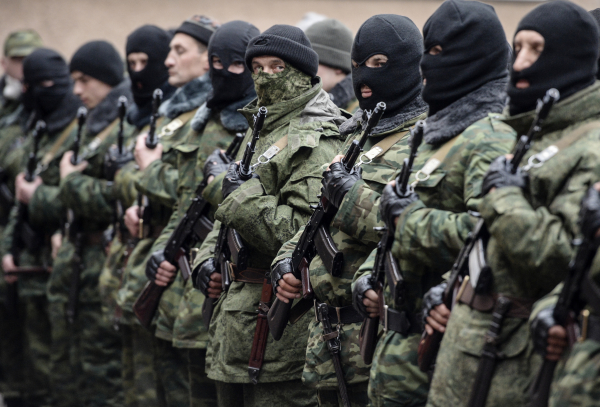Doing The Basil: Stalin 2.0 Must Prompt NATO Soul Searching
Posted on
Russia has just released its new strategy document formally identifying the United States and NATO as a threat to Russian interests, a new step since the last publication in 2009. NATO is welcoming the tiny state of Montenegro to the alliance. NATO supports the duly constituted government of Ukraine. In Vladimir Putin’s eyes, that is clearly enough to establish NATO and the US as “threats” to Russia. Bob Buttworth, a member of the Breaking Defense Board of Contributors, answers the question: what does NATO need to do to ensure Putin’s Russia does not do as Hitler and Stalin did. Read on. The Editor.
NATO is preparing “Readiness Action Plans” to forestall further Russian depredations, but it needs to do much more. Countering Russian strategy will require a strong political component; a strategy for national security, not just defense; and a willingness to deepen alliance relationships.
Putin’s aggression in Ukraine has been called a “new kind of threat” of “hybrid war,” but it actually follows a well-thumbed playbook. As described in 1946 by the noted strategist, Sir Basil Liddell Hart, an aggressor can succeed against an opponent with atomic weapons by exploiting political vulnerabilities for apparently limited aims, thereby creating ambiguity that hampers defensive responses.
In Liddell Hart’s words (on page 101 of his book, The Revolution in Warfare) an aggressor would be seeking to “exploit weaknesses in the opposition while abstaining from such a direct menace, on an obviously vital issue, as to precipitate an all-out struggle. It would seek to gain its ends as far as possible by ‘camouflaged war,’ carried out by power-policy maneuvers in the diplomatic field, and then, if necessary, go on to strategic operations against subsidiary states or outlying colonies.” The basic tactic would be infiltration, pursuing deep and widespread penetrations particularly of the target state’s civil apparatus to delay and complicate potential responses.
Hitler “did the Basil” in Austria and Czechoslovakia, and Stalin tried it soon after World War II ended. In late 1946 Soviet troops occupying northern Iran denied the Iranian government access to the area, protected the self-proclaimed “autonomous” regional government created by a communist revolt and through it gained influence in the national parliament. Earlier that year the USSR also proposed establishing military bases in Turkey, as well as taking control of the straits linking the Black Sea with the Aegean. There stood 25 Soviet divisions south of the Caucasus posing implicit threats to Turkey, as well as occupying part of Iran. These efforts were eventually defeated by British and American counterthreats and military assistance, backed by ready and appropriate forces — just the sort of mission envisioned for the forces of NATO’s new Readiness Action Plans.
Today such direct military confrontations could prove disastrous; the emphasis must be on preventing them from developing. The United States did so most dramatically in western Europe after World War II with a “whole of government” combination of programs: the Marshall Plan, the formation of NATO, support for creating the European Coal and Steel Community between Germany and France (father of the European Union), and extensive public diplomacy and covert action activities.
The goal today would again be to do something to “the left” of such a massive response, to preclude the need for it. Doing so will not be easy. The opportunities for an aggressor to do the Basil are created by the victim’s internal affairs, the product of discontents and stresses and grievances and shocks whether occasioned by domestic or international events.
There are many such that currently affect NATO’s members and neighbors. Politics in some countries are polarized in reactions to refugees, Muslim customs and domestic terrorism. Frustrations with the European Union — constraints and penalties on national economies, insecurity because of the common border—are shared by many. Former Warsaw Pact states with sizable ethnic Russian minorities face recurring cyber and clandestine harassment from Russia. Terrorism can trigger repressive overreactions by governments, and governmental corruption, disregard for human rights, and abandonment of commonly shared values can trigger further political upset.
None of these problems is likely soon to bring “green men” across NATO borders, but neither is NATO likely to deal with them. The alliance has long shunned any consideration of states’ internal affairs, especially those of its members. But with Putin and ISIL, domestic political issues can quickly become international security problems. If timely steps are to be taken to preclude the need for a future dramatic intervention:
- NATO members will have to pursue deeper, more intimate sharing on strategic issues;
- NATO’s strategic assessments will have to include states’ “internal affairs” and do so with a broad national security — not just military — perspective;
- NATO’s planning will have to include economic, diplomatic, public information, and other elements of national power beyond the military; and
- some new procedures will be needed to ensure confidentiality when considering such sensitive issues. Perhaps a model can be found in the LIVE OAK arrangements made to discuss possible nuclear operations during the 1958-61 Berlin crisis.
These measures plainly will require careful political management and intensive consultations, but today’s issues and technologies are not limited by national borders. The alliance that would result would be a new NATO with a new intimacy that would endow “extended deterrence” with new reality.
Subscribe to our newsletter
Promotions, new products and sales. Directly to your inbox.

